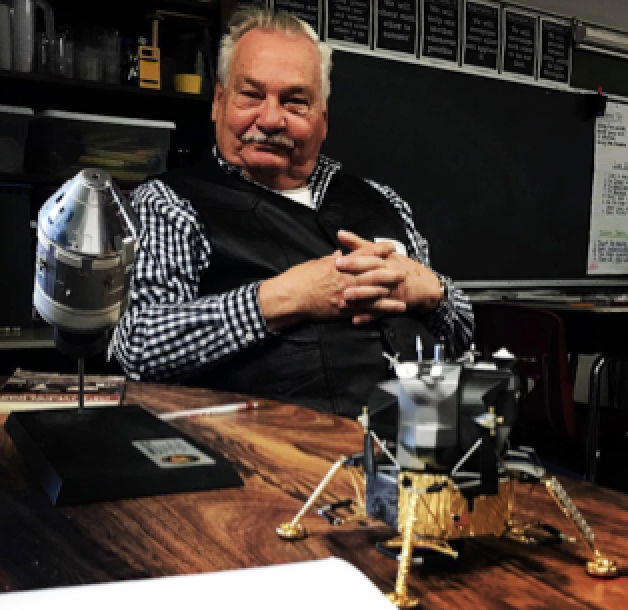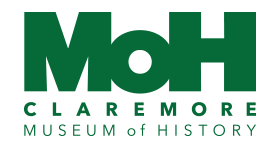
5th Grade – U.S. History: Stuart Roosa and Apollo 14
Overview:
Fifth grade students will learn about astronaut Stuart Roosa and Apollo 14. This program will meet fifth grade Oklahoma Academic Standards in English Language Arts, Visual Arts, Music, Social Studies, Science, and Math. The showcase artifact for this specific program will be Stuart Roosa’s star chart from Apollo 14. This star chart will be recreated as a visual art project activity. The volunteer collaborator for this fifth-grade outreach program is Ron Strothmann, a Claremore resident and former Quality Assurance Inspector for Grumman Aerospace—the company who designed, assembled, integrated and tested the Lunar Module for the Apollo program. Mr. Strothmann will speak to the class about the lunar module and what his role was at Grumman Aerospace, he will bring an educational artifact which happens to be a rare model of the Apollo 14 space crafts that can be disassembled to illustrate how it works.
Summary:
The artifact that students will learn about for this specific program will be Stuart Roosa’s star chart from Apollo 14. This artifact was chosen because he correlates with math, science, and social studies. Educational artifacts will be provided for object-based learning. Students will learn about Apollo 14 its importance in U.S. History as well as Stuart Roosa’s contributions to the mission. Each student will learn about astronomy, and create their own Apollo 14 star chart. Understanding of Apollo 14 will be explored via SmartBoard through video content and Google Moon which will provide information on lunar landing sites, narrated by Apollo astronauts; 3D models of rovers and landers; 360-degree photo panoramas; Rare TV footage of the Apollo missions.
90 Minute Program BREAKDOWN:
10 minutes: Welcome and Introduction
What is the MoH? Who are the volunteer collaborators? What are we learning about today?
15 minutes: Who is Stuart Roosa? What was Apollo 14
- Watch a brief clip on Apollo 14 from youtube via SmartBoard. Discuss Stuart’s life with classroom.
- Classroom discussion on the importance of the showcase artifact, Apollo 14 star-chart.
- Google Moon via SmartBoard and Calisthenics in Space examples
10 minutes: Space Math
Students will complete a word problem. They will use long division and long multiplication to complete the problem as well as critical thinking skills.
20 minutes: Object-based Learning
- Introduce educational artifacts. Discussion on each artifact and how it relates to the lesson.
AG7 Space Pen
Moon beach ball
Apollo space crafts model (this model can be disassembled to show all the moving parts of the Saturn V, Command Service Module and Lunar Module).
Globe
Claremore High School 1951 Yearbook (Stuart Roosa’s senior year)
Replica Apollo 14 Space Suit
15 minutes: Volunteer Collaborator
Ron Strothmann, will speak about the lunar module, his career, and answer questions pertaining to Apollo space crafts.
20 minutes: Activity
Each student will create their own Apollo 14 star chart. Discussion on astronomy.
Supplies
Apollo 14 Educational Artifact Collection
Markers and Crayons
Brass Fasteners
Pencils
Paper
OKLAHOMA ACADEMIC STANDARDS ACHIEVED
ELA (English Language Arts)
5.4.R.1 Students will increase knowledge of academic, domain-appropriate, grade-level vocabulary to infer meaning of grade-level text.
5.4.R.2 Students will use word parts ( e.g., affixes, Greek and Latin roots, stems) to define new words and determine the meaning of new words.
5.4.R.3 Students will use context clues to determine or clarify the meaning of words or distinguish among multiple-meaning words.
5.6.R.3 Students will determine the relevance and reliability of the information gathered.
5.6.W.2 Students will formulate a viable research question from findings.
5.7.R.1 Students will analyze the characteristics and effectiveness of a variety of written, oral, visual, digital, non-verbal, and interactive texts to generate and answer literal and interpretive questions to create new understandings.
5.7.R.2 Students will compare and contrast how ideas and topics are depicted in a variety of media and formats.
GENERAL MUSIC
STANDARD 2: Music History and Culture: “Connecting”
The student recognizes the development of music from an historical and cultural perspective.
5.2.2 Recognize, describe, and listen to music from a variety of styles, periods, cultures.
5.2.3 Identify and differentiate the use of musical elements and instruments form other parts of the world and compare them to the use of musical elements in American music.
MATH
5.N.1 Divide multi-digit numbers and solve real-world and mathematical problems using arithmetic.
5.N.1.1 Estimate solutions to division problems in order to assess the reasonableness of results.
5.N.1.2 Divide multi-digit numbers, by one- and two-digit divisors, using efficient and generalizable procedures, based on knowledge of place value, including standard algorithms.
5.N.1.3 Recognize that quotients can be represented in a variety of ways, including a whole number with a remainder, a fraction or mixed number, or a decimal and consider the context in which a problem is situated to select and interpret the most useful form of the quotient for the solution.
5.N.1.4 Solve real-world and mathematical problems requiring addition, subtraction, multiplication, and division of multi-digit whole numbers. Use various strategies, including the inverse relationships between operations, the use of technology, and the context of the problem to assess the reasonableness of results.
SCIENCE
5-PS2-1 Motion and Stability: Forces and Interactions
5-PS2-1.1 Asking questions (for science) and defining problems (for engineering).
5-PS2-1.2 Developing and using models
5-PS2-1.3 Planning and carrying out investigations
5-PS2-1.4 Analyzing and interpreting data
5-PS2-1.5 Using mathematics and computational thinking
5-PS2-1.6 Constructing explanations (for science) and designing solutions (for engineering)
5-PS2-1.7 Engaging in argument from evidence
5-PS2-1.8 Obtaining, evaluating, and communicating information
5-ESS1-1 Earth’s Place in the Universe
5-ESS1-1.1 Asking questions (for science) and defining problems (for engineering).
5-ESS1-1.2 Developing and using models
5-ESS1-1.3 Planning and carrying out investigations
5-ESS1-1.4 Analyzing and interpreting data
5-ESS1-1.5 Using mathematics and computational thinking
5-ESS1-1.6 Constructing explanations (for science) and designing solutions (for engineering)
5-ESS1-1.7 Engaging in argument from evidence
5-ESS1-1.8 Obtaining, evaluating, and communicating information
5-ESS1-2 Earth’s Place in the Universe
5-ESS1-2.1 Asking questions (for science) and defining problems (for engineering).
5-ESS1-2.2 Developing and using models
5-ESS1-2.3 Planning and carrying out investigations
5-ESS1-2.4 Analyzing and interpreting data
5-ESS1-2.5 Using mathematics and computational thinking
5-ESS1-2.6 Constructing explanations (for science) and designing solutions (for engineering)
5-ESS1-2.7 Engaging in argument from evidence
5-ESS1-2.8 Obtaining, evaluating, and communicating information
SOCIAL STUDIES
PROCESS AND LITERACY SKILLS (PALS) FOR LEARNING
Process and Literacy Skills Standard 1: The student will develop and demonstrate Common Core informational text reading literacy skills.
A. Key Ideas and Details
3. Explain the relationships or interactions between two or more individuals, events, ideas, or concepts in United States history primary and/or secondary sources based on specific information in the texts.
B. Craft and Structure
4. Determine the meaning of social studies–specific words and phrases in a text relevant to United States history and government.
5. Compare and contrast the overall structure (e.g., chronology, comparison, cause/effect historic problem/
solution) of events, ideas, concepts, or information in two or more texts.
6. Analyze multiple accounts of the same event or topic, noting important similarities and differences in the point of view they represent.
C. Integration of Knowledge and Ideas
7. Draw on information from multiple print or digital sources (e.g., timelines, maps, graphs, charts, political cartoons, images, artwork), demonstrating the ability to locate an answer to a question or to solve an historic problem.
VISUAL ARTS
STANDARD 3: Visual Art Expression: “Creating”
The student will observe, select, and utilize a variety of ideas and subject matter in creating original works of art.
5.3.1 Create original visual artworks using a variety materials, techniques, and sources for ideas.
5.3.1 Use observation, memory and imagination in creating original works of art.
STANDARD 4: Visual Art Appreciation: “Connecting”
The student will appreciate and utilize visual art to make interdisciplinary connections and informed aesthetic decisions. 5.4.4 Make learning connections between visual art and other disciplines, such as mathematics, science, ELA, social studies, and media arts.
